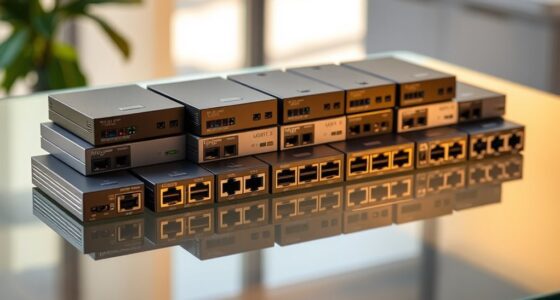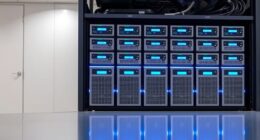If you’re looking for the top storage servers with RAID 10 to maximize both performance and data reliability, I recommend exploring options like the Asustor Lockerstor 10 Gen3, HPE ProLiant models, and TERRAMASTER NAS systems, which support large capacities and high speeds. These setups combine robust hardware, multiple drive bays, and advanced security features—all essential for demanding workloads. Keep exploring further, and you’ll discover more details to help choose the perfect solution for your needs.
Key Takeaways
- Look for servers supporting multiple drive bays (e.g., 10+ bays) with RAID 10 capabilities for optimal redundancy and speed.
- Prioritize models with high-performance CPUs (Intel Xeon or similar) and ample RAM (up to 256GB) for demanding workloads.
- Ensure compatibility with high-capacity drives (up to 24TB) and hardware encryption features for data security.
- Choose servers with high transfer speeds (10GbE, 20GbE, or Thunderbolt) to maximize data throughput.
- Consider energy-efficient designs that balance power consumption with performance for reliable, long-term operation.
4 Bay Hard Drive RAID Enclosure with Cooling Fan for 2.5/3.5 SATA HDD/SSD
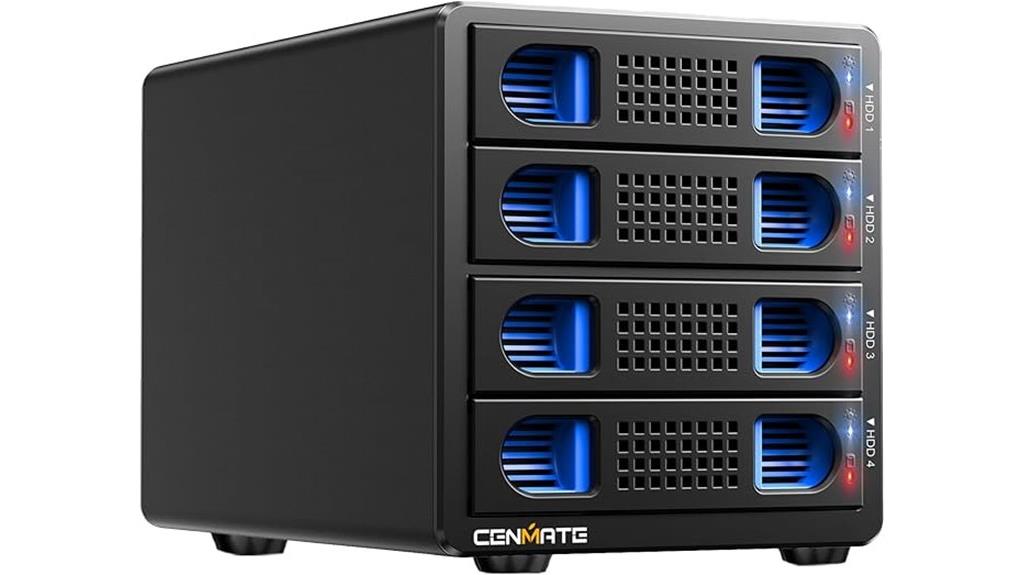
If you’re looking for a reliable and flexible storage solution for both personal and small business use, the 4 Bay Hard Drive RAID Enclosure with Cooling Fan is an excellent choice. It supports 2.5/3.5-inch SATA HDD/SSD drives with a total capacity up to 80TB, making it perfect for large data needs. The enclosure connects via USB 3.0 and eSATA, ensuring fast and stable data transfer. Its aluminum-alloy body and 2-inch fans keep drives cool, preventing overheating. Plus, with multiple RAID modes, you can customize your setup for performance or redundancy. No extra software is needed, and it’s compatible with Windows, Mac, and Linux systems.
Best For: individuals and small businesses needing a reliable, high-capacity external storage solution with flexible RAID options and robust cooling.
Pros:
- Supports up to 80TB total capacity with 2.5/3.5-inch SATA HDD/SSD drives.
- Multiple RAID modes (0/1/3/5/10, CLONE, LARGE, NORMAL) for customizable performance and redundancy.
- Equipped with aluminum-alloy body and 2-inch fans for effective heat dissipation and cooling.
Cons:
- Fan noise ranges around 40-50 decibels, which may be unsuitable for noise-sensitive environments.
- Changing RAID modes can cause data loss and requires specific procedures; no RAID software for Mac.
- Requires disconnecting power and manual toggling to switch RAID modes, which may be inconvenient for some users.
HPE ProLiant DL360 Gen11 Rack Server Bundle

The HPE ProLiant DL360 Gen11 Rack Server Bundle stands out as an ideal choice for large enterprises and small businesses seeking a high-performance, secure, and versatile server capable of handling demanding workloads. It features the latest Xeon Scalable processors, DDR5 memory, and PCIe Gen5 slots, ensuring fast data processing and expansion. With 256GB of ECC buffered memory and up to 30.72TB of enterprise SSD storage, it’s optimized for virtualization, databases, and data acceleration. Remote management via iLO 6, hot-swappable power supplies, and a compact 1U form factor make this server reliable, scalable, and easy to operate for diverse enterprise needs.
Best For: large enterprises and small businesses seeking a high-performance, secure, and versatile server for demanding workloads like virtualization and data acceleration.
Pros:
- Equipped with the latest Xeon Scalable processors and DDR5 memory for optimal performance
- Supports extensive storage capacity with up to 30.72TB of enterprise SSDs and redundant hot-swappable power supplies
- Features remote management via iLO 6, simplifying administration and maintenance
Cons:
- Higher initial cost due to advanced hardware and enterprise features
- Requires separate purchase and installation for additional drives and memory upgrades
- Physical size and weight may require specialized rack installation and handling
TERRAMASTER F6-424 Max NAS Storage

The TERRAMASTER F6-424 Max NAS Storage stands out as an ideal choice for small to medium-sized businesses requiring reliable, high-performance RAID 10 setups. It features a powerful Core i5 1235U processor, 8GB DDR5 RAM, and dual M.2 NVMe slots for hyper caching, delivering over 220% performance gains. With six drive bays and dual 10GbE ports, it supports speeds up to 20Gbps, enabling fast data transfers—up to 2090MB/s sequential writes. Its quiet operation, advanced security with AES encryption, and multimedia streaming capabilities make it versatile for demanding workflows. Plus, extensive backup solutions ensure data integrity and protection for business continuity.
Best For: small to medium-sized businesses seeking a high-performance, reliable NAS with advanced security and fast data transfer capabilities.
Pros:
- Powerful Core i5 1235U processor with hyper caching for exceptional performance
- Dual 10GbE ports supporting up to 20Gbps bandwidth for rapid data transfer
- Robust security features including AES encryption and enterprise backup solutions
Cons:
- Higher cost may be a barrier for very small or budget-conscious businesses
- Requires technical knowledge for optimal setup and management
- Limited to 6 drive bays, which may be insufficient for large-scale storage needs
Asustor Lockerstor 10 Gen3 NAS (AS6810T)
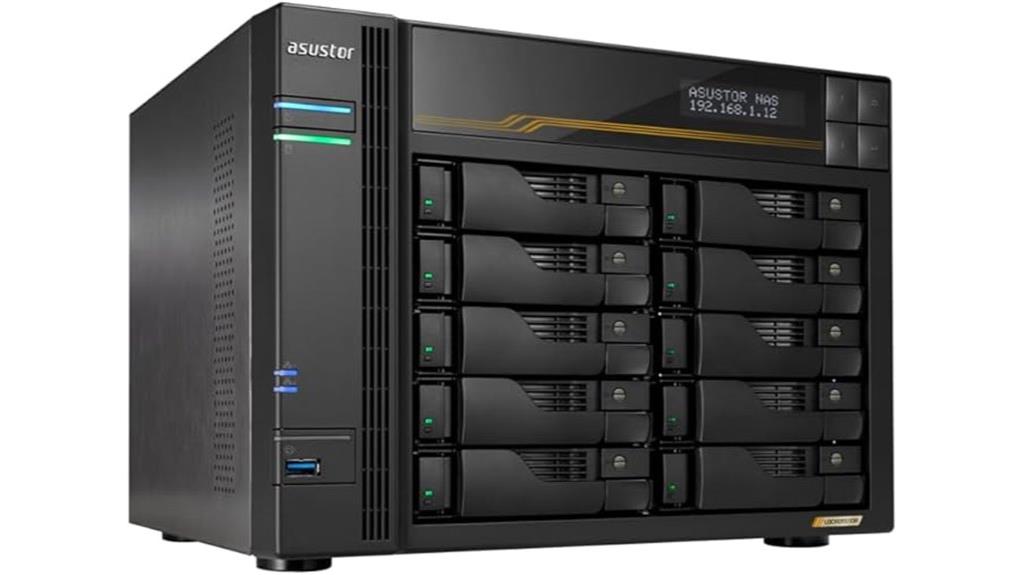
For users seeking a high-performance NAS with robust RAID options, the Asustor Lockerstor 10 Gen3 NAS (AS6810T) stands out thanks to its support for RAID 6 and hot-swappable drives. Its powerful hardware includes a quad-core AMD Ryzen CPU, 16GB DDR5 ECC RAM, and PCIe 4.0 M.2 slots for caching. Dual 5GbE and 10GbE ports, along with USB 4.0 and multiple USB 3.2 ports, ensure fast connectivity. The device’s design emphasizes build quality and quiet operation. While disassembly for upgrades can be tricky, the system’s reliability, extensive software features, and ability to automatically rebuild RAID arrays make it a versatile, high-performance storage solution.
Best For: power users and small businesses seeking a high-performance, versatile NAS with advanced RAID options, extensive connectivity, and robust hardware capabilities.
Pros:
- Supports RAID 6 with hot-swappable drives for reliable data protection and easy maintenance
- Equipped with powerful AMD Ryzen CPU, DDR5 ECC RAM, and PCIe 4.0 M.2 slots for high-speed caching and performance
- Extensive connectivity options including dual 5GbE and 10GbE ports, USB 4.0, and multiple USB 3.2 ports
Cons:
- Disassembly for upgrades can be challenging and may risk damaging small screws
- Higher cost compared to similar storage solutions, especially with added SSD caching expenses
- Occasional system lock-ups and limited utility of the device’s display may require additional management efforts
TERRAMASTER F8 SSD NAS Storage
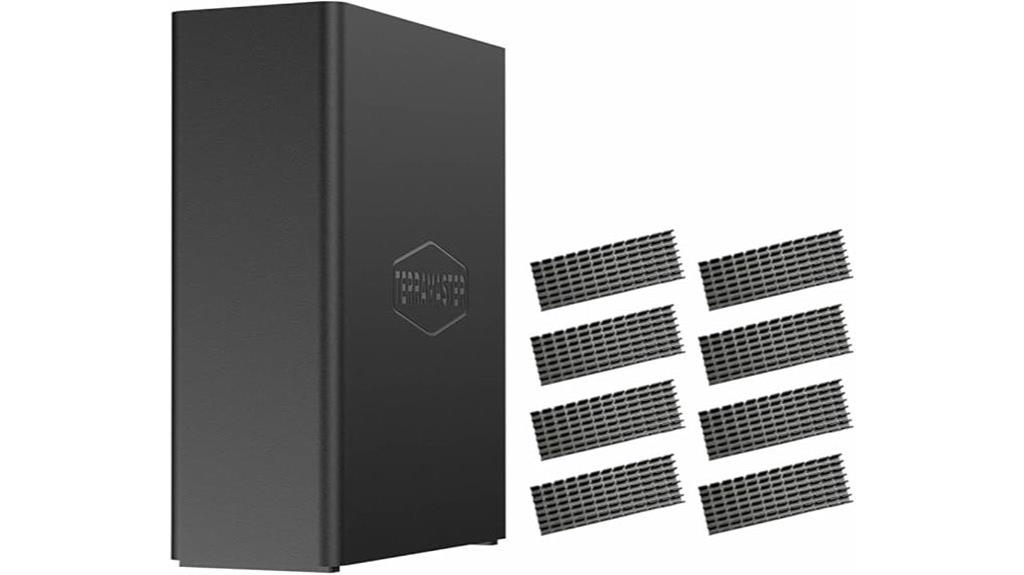
Looking for a compact, high-performance NAS that handles demanding workloads with ease? The TERRAMASTER F8 SSD NAS Storage is an all-SSD, 8-bay device designed for speed and portability. Powered by an Intel N95 quad-core processor and 8GB DDR5 RAM, it delivers transfer speeds up to 1024MB/s over 10GbE. Its lightweight, palm-sized design makes it perfect for small spaces or travel. Supporting up to 8TB SSDs (totaling 64TB), it features efficient cooling, silent operation, and easy tool-free drive installation. Ideal for media streaming, backups, and demanding tasks, it combines high performance with a compact form factor.
Best For: power users and small businesses seeking a portable, high-speed SSD NAS for demanding workloads like media streaming, backups, and data management.
Pros:
- Exceptional transfer speeds up to 1024MB/s with 10GbE connectivity for quick data access and transfer
- Compact, lightweight design ideal for portability and space-constrained environments
- Efficient cooling system with silent operation, maintaining low temperatures under load
Cons:
- Setup for RAID configurations can be time-consuming and complex for some users
- Default OS (TOS) may feel unfamiliar to Linux users, requiring OS replacement for advanced customization
- Limited maximum RAM support constrained by CPU, despite claims of higher support, affecting expandability
UGREEN NASync DXP2800 2-Bay Desktop NAS

If you’re seeking an affordable yet powerful storage solution, the UGREEN NASync DXP2800 2-Bay Desktop NAS makes a great choice, especially for users who want to optimize data security and performance with RAID 10. It offers up to 76TB of storage, perfect for backing up files, photos, and videos. The device features automatic photo organization, face and scene recognition, and 4K HDMI output for home entertainment. With a 12th Gen Intel N100 quad-core CPU, 8GB DDR5 RAM, and a 2.5GbE port, it delivers fast transfer speeds and smooth multitasking. Plus, its secure private cloud and 2-year warranty add extra peace of mind.
Best For: users seeking an affordable, high-capacity, and secure local storage solution with advanced media and multitasking capabilities.
Pros:
- Supports up to 76TB of storage, ideal for large backups and media libraries
- Features automatic photo organization, face/scene recognition, and 4K HDMI output for entertainment
- Equipped with fast 2.5GbE network port and powerful Intel N100 quad-core CPU for quick data transfer and smooth multitasking
Cons:
- Requires separate purchase of hard drives compatible with third-party drives from brands like Western Digital or Seagate
- Limited to 2-bay capacity, which may not suit very large or scalable storage needs
- May be more complex for users unfamiliar with setting up RAID configurations and network sharing
UGREEN NASync DXP6800 Plus 6-Bay Desktop NAS

The UGREEN NASync DXP6800 Plus 6-Bay Desktop NAS stands out as an ideal choice for those who need a high-performance, scalable storage solution with robust data protection. It features a powerful 12th Gen Intel Core i3 processor, 8GB DDR5 RAM, and supports up to six SATA drives plus two M.2 NVMe slots for a total capacity of 196TB. With a 10GbE port and 2.5GbE port, it delivers network speeds up to 20GbE and transfer rates of 1250MB/s. Its flexible RAID options, including RAID10, ensure data redundancy and performance. Designed for both home and business, it combines speed, security, and expandability in a compact desktop form.
Best For: home users and small businesses seeking a high-speed, scalable, and secure network-attached storage solution with extensive data protection features.
Pros:
- Supports up to 196TB of storage with flexible RAID configurations for redundancy and performance.
- Equipped with 10GbE and 2.5GbE ports for ultra-fast network speeds up to 20GbE and transfer rates of 1250MB/s.
- Robust data security with automatic backups, encryption, and certified privacy standards, ensuring data remains private and protected.
Cons:
- Being diskless, it requires users to purchase compatible drives separately for storage setup.
- Its advanced features and configurations may require technical knowledge for optimal use.
- The desktop form factor, while compact, may limit expandability compared to rack-mounted solutions.
QNAP TS-464-8G-48WD-US Desktop NAS with 24TB Storage
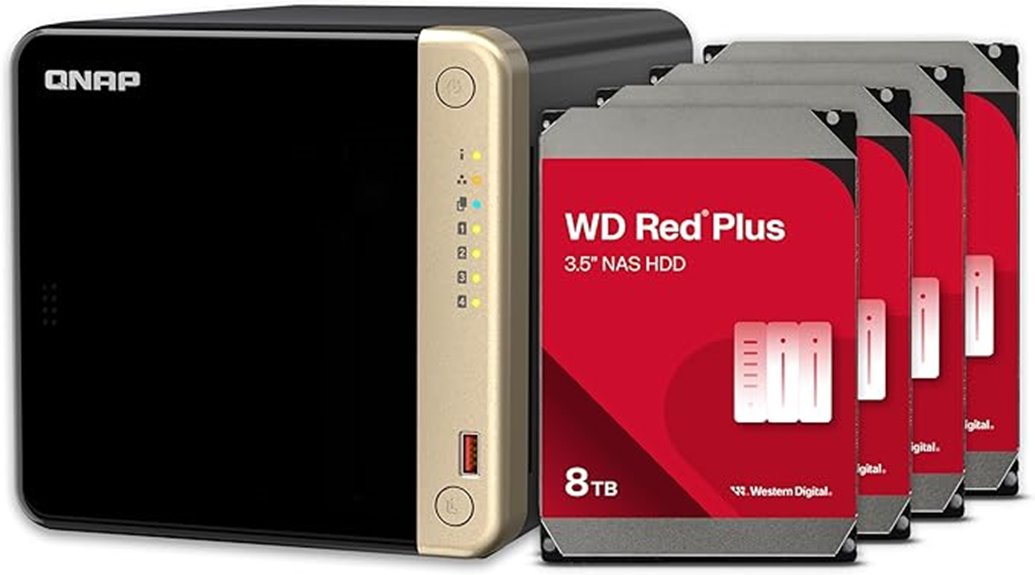
For those seeking a reliable storage solution with high performance and data redundancy, the QNAP TS-464-8G-48WD-US is an excellent choice. It features four bays with pre-installed 8TB WD Red Plus drives configured in RAID 5, giving you 24TB of protected storage. Powered by an Intel Celeron quad-core processor and supporting up to 16GB RAM, it delivers fast data transfer via dual 2.5GbE ports. The system includes two M.2 SSD slots for caching, multiple USB ports, and hardware encryption for security. Its compact design and user-friendly interface make it ideal for media storage, backups, and small business applications.
Best For: users seeking a high-performance, reliable NAS for media storage, backups, and small business needs with data redundancy and expandability.
Pros:
- Robust performance with Intel quad-core processor and support for up to 16GB RAM
- Multiple connectivity options including dual 2.5GbE ports and USB 3.2 ports for fast data transfer
- Supports RAID 5 configuration with pre-installed drives ensuring data redundancy and protection
Cons:
- Slightly heavy and large for a desktop device, may require dedicated space
- USB backup functionalities can sometimes encounter issues with specific files
- Upgrading RAM or adding SSD caches requires verifying compatible slots and components
BUFFALO TeraStation 5420DN 4-Bay Desktop NAS with Hard Drives
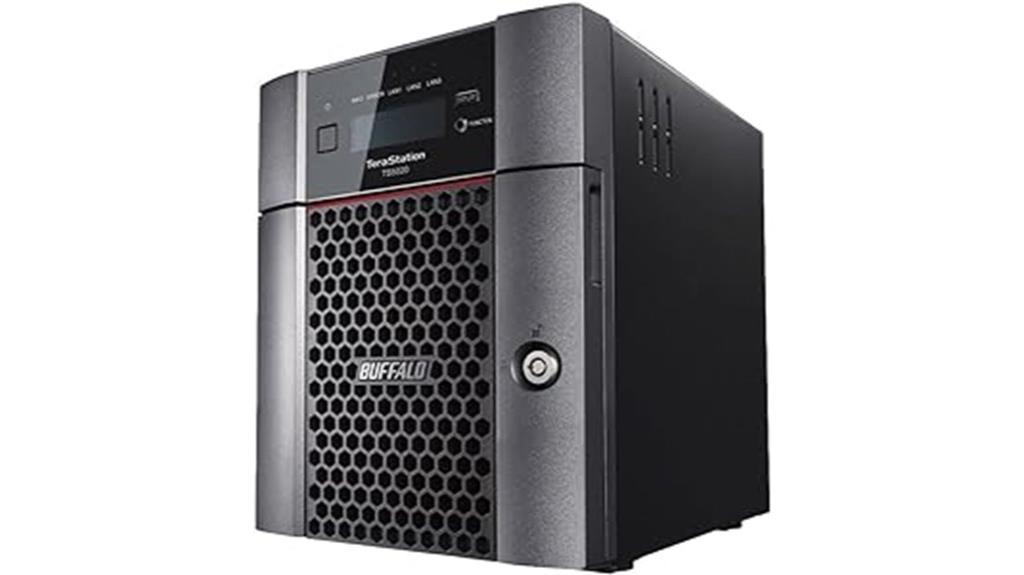
Designed for small to medium-sized businesses, the BUFFALO TeraStation 5420DN 4-Bay Desktop NAS with Hard Drives offers robust RAID 10 support, providing a perfect balance of data redundancy and performance. It comes with 16TB of storage (2x8TB drives included) and features a compact, 12 x 14 x 14-inch chassis. Equipped with a serial ATA-600 interface and a 5600 RPM drive speed, it supports high-speed data transfers via its native 10GbE port. With advanced hardware, 256-bit encryption, two-factor authentication, and cloud integration, it guarantees data security and easy backup. Customer feedback highlights its reliability and ease of setup, making it ideal for growing businesses.
Best For: small to medium-sized businesses seeking reliable, high-speed NAS storage with advanced security features.
Pros:
- Supports RAID 10 for optimal data redundancy and performance
- Equipped with a native 10GbE port for fast data transfers
- Includes comprehensive security features like 256-bit encryption and two-factor authentication
Cons:
- Limited to 16TB of storage in the included configuration, which may require additional drives for larger needs
- Larger than some desktop models, potentially affecting space considerations
- Requires familiarity with network and storage management for optimal setup
TERRAMASTER D5-310 HDD Enclosure 5Bay

If you’re seeking a reliable, multi-drive storage solution with robust RAID support, the TERRAMASTER D5-310 HDD Enclosure is an excellent choice. It supports five drives with hardware RAID options like RAID 5, 0, 1, 10, and single mode, ensuring flexibility and data protection. Compatible with Windows, macOS, and Linux, it requires no extra drivers. The enclosure features a dedicated RAID knob for simple mode switching, hot spare drive support, and durable aluminum construction. With up to 120TB capacity and transfer speeds around 220MB/s via USB 3.1 Gen 1, it’s well-suited for demanding workflows and multi-platform environments.
Best For: users seeking a versatile, high-capacity multi-drive storage enclosure with robust hardware RAID support for professional workflows, multi-platform compatibility, and reliable data protection.
Pros:
- Supports multiple hardware RAID modes including RAID 5, 0, 1, 10, and Single, offering flexible data protection options
- Compatible with Windows, macOS, and Linux without extra drivers, ideal for multi-platform environments
- Features a dedicated RAID knob, hot spare support, and durable aluminum construction for ease of use and longevity
Cons:
- Customer reviews indicate potential setup issues and RAID recognition problems
- Some users experience drive detection failures or RAID rebuild failures leading to data loss
- The device’s size and build may be considered bulky for certain setups
HPE ProLiant ML350 Gen11 Tower Server

The HPE ProLiant ML350 Gen11 Tower Server stands out as an excellent choice for organizations seeking reliable, high-performance storage solutions with RAID 10 capabilities. Its dual Intel Xeon Gold 5416 processors deliver 16 cores each, ensuring robust processing power. With 256GB DDR5 RAM and 15.36TB of enterprise SSD storage, it’s optimized for fast, reliable data access. Designed for hybrid environments, it offers flexible deployment options, plus security features and advanced management tools like iLO. Ideal for virtualized workloads, this server combines scalability, performance, and resilience, making it a versatile foundation for a high-performance storage array with RAID 10 for maximum data safety.
Best For: organizations seeking a high-performance, reliable storage solution with robust processing power and advanced security features for virtualized and hybrid environments.
Pros:
- Equipped with dual Intel Xeon Gold 5416 processors delivering strong multi-core performance
- Large 256GB DDR5 RAM for efficient handling of demanding workloads
- 15.36TB of enterprise SSD storage ensures fast, reliable data access
Cons:
- Hard drives and memory upgrades are sold separately, requiring additional installation steps
- Higher initial investment due to high-end hardware and enterprise features
- May require technical expertise for optimal deployment and management
Asustor Lockerstor 10 Pro NAS

The Asustor Lockerstor 10 Pro NAS stands out as an excellent choice for small businesses or advanced users needing high expandability and reliable data protection. It features 10 SATA3 bays supporting HDDs and SSDs, with a total capacity up to 180TB. Powered by an Intel Xeon E-2224 quad-core CPU and up to 64GB of RAM, it delivers strong performance. Dual 2.5GbE ports and M.2 NVMe SSD cache slots ensure fast data transfer and responsiveness. Its robust hardware supports RAID configurations like RAID 10 for maximum performance and redundancy. While RAM upgrades require disassembly, the Lockerstor offers versatile connectivity, virtualization support, and a user-friendly interface, making it ideal for demanding storage needs.
Best For: small businesses and advanced users seeking high expandability, reliable data protection, and robust performance in a network storage solution.
Pros:
- Highly expandable with 10 SATA3 bays supporting up to 180TB total capacity
- Powerful Intel Xeon processor and up to 64GB RAM for demanding applications
- Supports virtualization, high-speed networking, and RAID configurations for redundancy
Cons:
- RAM upgrades require disassembly, which can be challenging for some users
- The app ecosystem is less extensive compared to competitors like Synology or QNAP
- The device is relatively expensive, especially with additional drives and upgrades
WD 16TB My Book Duo Desktop RAID External Hard Drive

Are you seeking a reliable external drive that combines massive storage capacity with fast data transfer speeds? The WD 16TB My Book Duo Desktop RAID External Hard Drive delivers just that. Equipped with RAID-0 readiness out of the box, it provides sequential read speeds up to 360MB/s, thanks to WD Red drives and a USB Type-C port. It supports USB 3.1 Gen 1, USB 3.0, and USB 2.0, with all cables included. Features like hardware encryption, password protection, and two USB hub ports enhance security and usability. Its sleek black design and reliable performance make it ideal for backing up large media libraries and data-intensive projects.
Best For: users needing high-capacity, fast, and secure external storage for professional media editing, large data backups, or creative projects.
Pros:
- Massive 16TB storage capacity suitable for large media files and backups
- High-speed data transfer with RAID-0 support, reaching up to 360MB/s read speeds
- Enhanced security features including hardware encryption and password protection
Cons:
- Physical impacts like drops can cause hardware failure or data loss despite robust design
- Requires professional data recovery if physically damaged, which can be costly and time-consuming
- Compatibility issues may arise with older or lower USB versions, limiting performance without the proper ports
Factors to Consider When Choosing a Storage Server With Raid 10

When selecting a storage server with RAID 10, I consider several key factors to guarantee it meets my needs. These include evaluating my storage capacity requirements, checking hardware compatibility, and appraising performance and speed. I also look at redundancy, reliability, and how well the system can expand over time.
Storage Capacity Needs
Determining your storage capacity needs is essential to selecting a suitable RAID 10 server that can grow with your data requirements. First, assess how much data you currently store and project future growth to ensure the server can handle both. Remember, RAID 10’s usable space is roughly half of the total raw capacity of all disks combined, so plan accordingly. Check the maximum supported drive size and number of bays to confirm you can expand as needed. Since RAID 10 requires at least four drives, ensure you have enough disks to meet your capacity and redundancy goals. Finally, evaluate your storage growth rate against the server’s maximum capacity to avoid frequent upgrades or replacements, guaranteeing long-term scalability.
Hardware Compatibility Checks
To select a storage server with RAID 10 that meets your needs, you must first confirm its hardware components are fully compatible. Ensure the motherboard and controller support RAID 10, including compatible modes and firmware updates, to avoid issues down the line. Check that the drive bays and connectors match your intended drives, whether SATA or NVMe SSDs, and support the necessary capacity. Verify that the CPU and RAM meet performance demands for high-speed, reliable RAID 10 arrays. Additionally, confirm that the power supply and cooling systems can handle the heat and power load from multiple drives. Ultimately, review compatibility with your operating system and RAID management software to ensure smooth setup and ongoing management.
Performance and Speed
Performance and speed are critical factors when selecting a storage server with RAID 10, as this configuration is designed to maximize data throughput. RAID 10 combines striping and mirroring, offering high read and write speeds ideal for demanding applications. It requires at least four drives, with the potential to double data transfer rates by leveraging multiple disks simultaneously. Sequential read and write speeds in RAID 10 are often close to the total throughput of all drives, markedly improving data access times. These performance benefits are most evident during large file transfers and data-heavy workflows like media editing or virtualization. However, the actual speed also depends on the quality of the drives and the efficiency of the controller managing multiple data streams.
Redundancy and Reliability
Redundancy and reliability are crucial factors to take into account when choosing a storage server with RAID 10, as this configuration is designed to protect data against drive failures. RAID 10 combines mirroring and striping, storing duplicate data across pairs of drives, which means the failure of one drive in each mirrored pair won’t cause data loss. This setup offers high availability and fault tolerance, allowing the system to continue functioning even if up to half the drives fail, as long as failures occur in separate pairs. To maximize reliability, regular monitoring and maintenance are essential to detect potential drive issues early. Overall, RAID 10 provides a robust balance of performance and data protection, making it ideal for critical storage environments.
Expandability Options
When selecting a storage server with RAID 10, considering its expandability options can make a significant difference in long-term usability. I look for servers that support multiple drive bays and allow easy addition or replacement of drives to increase capacity. It’s essential that the RAID controller or software can expand existing RAID 10 arrays without complete reconfiguration or data migration, saving time and reducing risk. I also check if the server permits upgrading drives to higher capacities over time, ensuring scalable storage. The physical design matters too; a chassis that accommodates future drive additions or replacements is vital, especially in space-constrained environments. Finally, I verify that firmware and management tools facilitate seamless expansion and migration, minimizing downtime and safeguarding data integrity.
Power Consumption Levels
Power consumption is an important factor to regard because it directly impacts ongoing operational costs and energy efficiency. Storage servers with RAID 10 vary in power use depending on hardware components like processors, drives, and cooling systems. Servers equipped with high-performance CPUs and multiple drives tend to consume more energy, which can increase electricity bills over time. To optimize power efficiency, look for servers with efficient power supplies and energy-saving features such as drive spin-down and low-power states. Many monitoring tools and hardware specifications provide detailed power usage metrics, helping you compare options. Striking a balance between power consumption and performance is key: lower energy use may limit hardware capabilities, while higher power levels support faster processing and redundancy.
Security and Encryption
Security and encryption are essential considerations when selecting a storage server with RAID 10, especially if you handle sensitive data. Implementing hardware-based encryption can protect data at rest from unauthorized access, giving peace of mind. Using AES-256 encryption provides robust security for sensitive information stored across RAID 10 arrays. To maintain performance without sacrificing security, it’s important that the server’s hardware controllers or software solutions are compatible with encryption protocols. Regular firmware updates are fundamental to patch vulnerabilities and keep encryption methods secure. Additionally, encrypting data before it enters the RAID 10 array adds an extra layer of protection, especially when transmitting over unsecured networks. These security measures help guarantee your data remains safe, confidential, and compliant with industry standards.
Budget Considerations
Choosing a storage server with RAID 10 involves careful consideration of your budget, as the setup can be costly. RAID 10 requires at least four drives, which can markedly increase upfront hardware expenses compared to other RAID levels. High-capacity drives, like 16TB or 24TB models, can further inflate costs. Budget constraints might lead you to opt for cheaper drives, smaller capacities, or fewer components, but this can compromise data safety and the benefits of redundancy. Additionally, expenses for cooling, expansion cards, or hardware monitoring tools should be factored into your overall budget. Being mindful of these costs ensures you balance performance and reliability without overspending, helping you choose a storage solution that aligns with your financial limits while meeting your needs.
Frequently Asked Questions
How Does RAID 10 Impact Data Recovery Times?
RAID 10 speeds up data recovery because it mirrors data across pairs of disks, so if one disk fails, the system quickly switches to the mirror without losing data. I’ve found recovery times are much faster compared to other RAID levels, as only the failed disk needs replacement and rebuilding. This setup minimizes downtime, giving me confidence that my data stays accessible and protected with minimal interruption.
Can RAID 10 Improve Performance for Virtualized Workloads?
Oh, absolutely, RAID 10 can make virtualized workloads fly—if you enjoy juggling speed and reliability. I’ve seen it turn sluggish virtual machines into smooth operators, thanks to mirrored pairs and striped data. It’s like giving your server a turbo boost while keeping backups safe. So yes, RAID 10 doesn’t just improve performance; it transforms your virtualization experience into something much more efficient and resilient.
What Are the Best Practices for Maintaining RAID 10 Arrays?
To keep RAID 10 arrays running smoothly, I recommend regularly monitoring their health using management tools like SMART. Always guarantee your firmware and drivers are up to date, and perform periodic backups in case of failure. I also practice consistent disk checks and replace drives at the first sign of issues. Proper cooling and power supply management are vital to prevent hardware failures, so I stay vigilant with these aspects as well.
How Does RAID 10 Compatibility Vary Across Different Server Brands?
RAID 10 compatibility varies quite a bit across server brands. I’ve found that top-tier brands like Dell, HP, and Lenovo generally offer robust support and seamless integration for RAID 10 arrays, but some less-known brands might have limited support or compatibility issues. It’s essential to check each server’s specifications and firmware updates before purchasing, so you guarantee the RAID 10 setup works smoothly with your chosen hardware.
Is Hardware or Software RAID Better for RAID 10 Configurations?
Think of your data as a precious treasure; choosing between hardware and software RAID is like selecting a sturdy chest or a clever lock. I believe hardware RAID is better for RAID 10 because it offers dedicated performance and reliability, much like a solid chest that keeps your treasure safe. Software RAID can work, but it’s more like relying on a lock that’s easier to pick—less robust for demanding setups.
Conclusion
Ultimately, selecting a superb storage server with RAID 10 boils down to balancing best performance, reliable redundancy, and budget. By bringing together bold brand options and thoughtful features, you can confidently choose a setup that suits your specific needs. Remember, the right RAID choice delivers not just storage but steadfast security and speed—so don’t settle for less. With the right RAID, you’re really reinforcing your data’s durability and drive for development!




